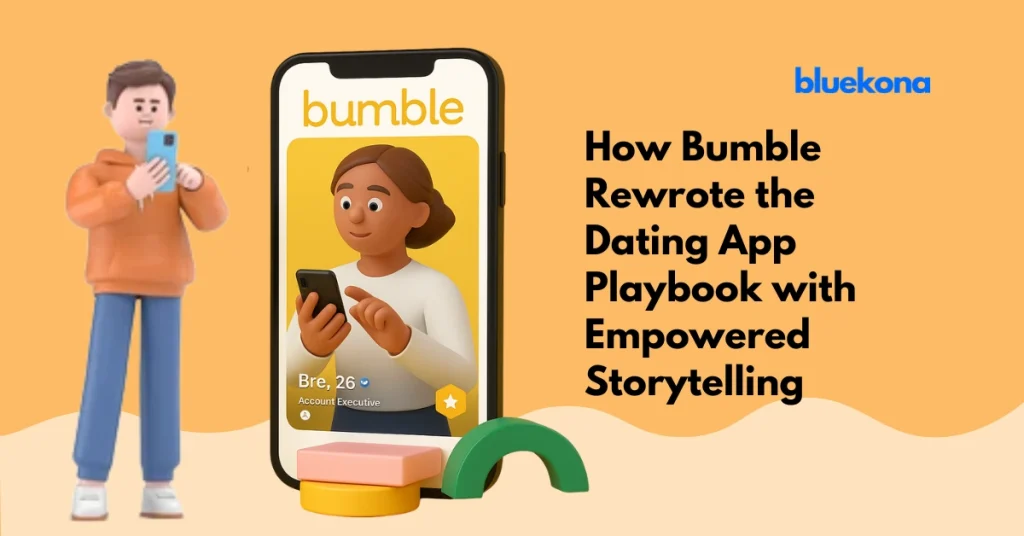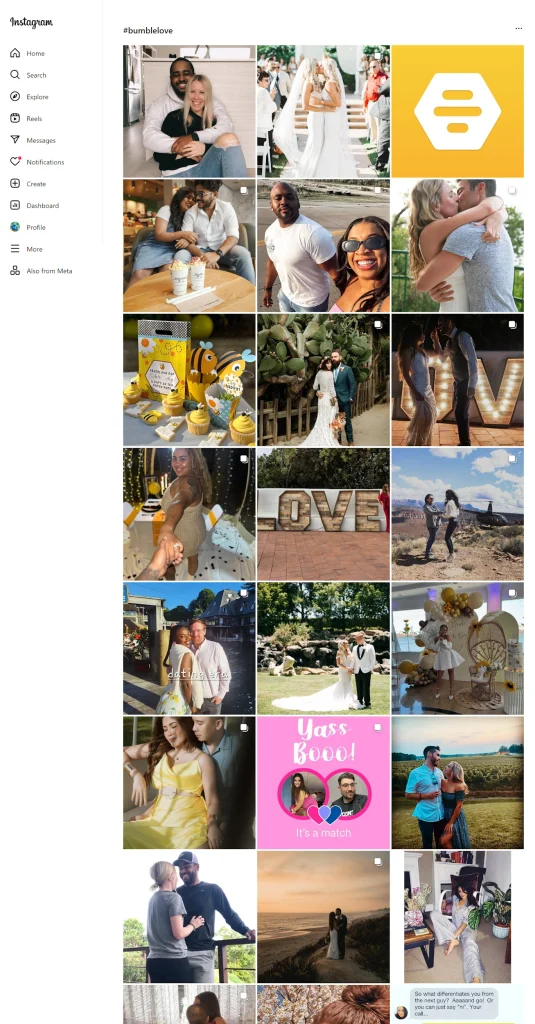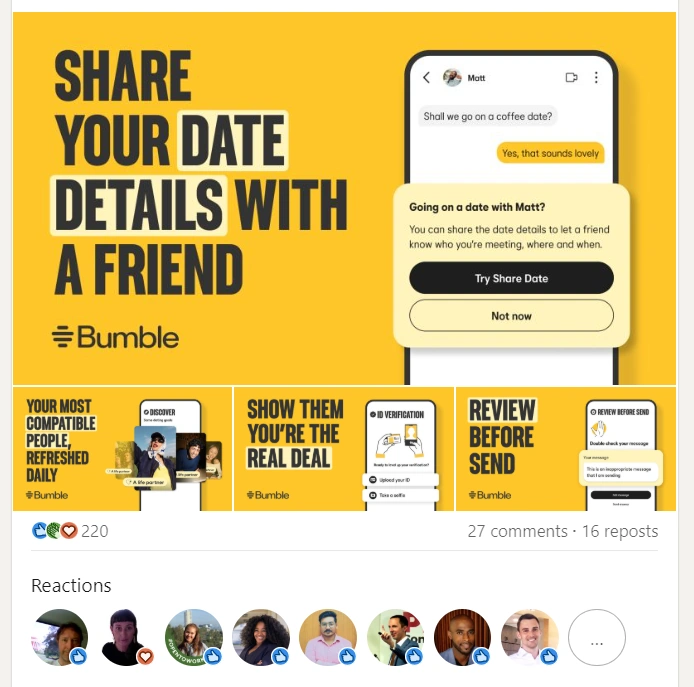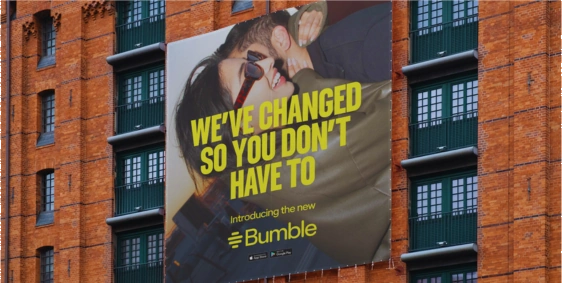
Back in 2014, dating apps felt like a never-ending cycle of swipe fatigue and shallow matches. Tinder was the king of the hill, and Match Group had the cash to back it up. But what they did not have? A brand that women could genuinely trust.
Back in 2014, most dating apps were all about quantity. Swipe more, match more, message more. But this approach created a toxic cycle, especially for women, who often found themselves overwhelmed by low-effort messages and unwanted advances.
Bumble’s breakthrough wasn’t just another feature. It was a shift in power dynamics. By making it a rule for women to initiate the conversation within 24 hours, Bumble didn’t merely adjust user habits—it completely redefined the dating game.
This wasn’t just about improving user experience, it was a philosophy embedded in the product. And this philosophy arrived at just the right time. In a society that was increasingly prioritizing consent, safety, and respect in the digital realm, Bumble transformed into more than just a dating app—it became a movement.
Bumble’s brilliance lay in turning a simple interaction rule into a broader cultural statement. Their messaging was refreshingly straightforward.
While other apps focused on matches, algorithms, and endless choices, Bumble emphasized autonomy, safety, and mutual respect.
Whether it was app store descriptions, billboard advertisements, or push notifications, every message echoed the same empowering idea: make the first move.
What made Bumble resonate wasn’t just their messaging—it was how the app functioned. Their “women first” rule wasn’t merely a marketing gimmick, it was ingrained in the app’s very code.
This harmony between values and actions turned users into passionate advocates. Women shared their experiences of feeling safer and more in control, while men appreciated the thoughtfulness behind their interactions. The mechanics of the product became the message, and that message sparked a movement.
In a crowded space filled with feature-hunters and acquisition strategies, Bumble demonstrated that true differentiation occurs where values and behavior intersect.
Having a powerful message is one thing, but delivering that message consistently across all the platforms your audience frequents is a whole different game. Bumble didn’t just participate in this challenge,n they absolutely nailed it.
From Instagram and TikTok to LinkedIn and real-world campaigns, Bumble showcased what we might call omnichannel brand discipline. Every interaction, whether it’s a billboard or a push notification, echoed Bumble’s unmistakable vibe — bold, witty, and empowering.
But let’s be clear, this wasn’t just a matter of copying and pasting content. It was all about smart adaptation. Bumble skillfully adjusted its voice to fit the unique style of each platform while staying true to its core values.
Let’s talk about storytelling on different platforms!
This space is all about bright, eye-catching visuals paired with motivational quotes, fun dating myth busts, and user-generated content. It’s a feed designed to inspire and foster a sense of belonging—just right for Bumble’s uplifting vibe.

Here, the content is short, emotionally resonant, and often refreshingly candid. It connects with Gen Z by embracing vulnerability, humor, and empowerment, all wrapped up in the latest trending formats.
When it comes to Bumble Bizz, the tone takes on a more polished, professional flair. Picture career advice, confidence-boosting tips, and inspiring stories of women smashing through glass ceilings—while still keeping Bumble’s signature voice intact.

From eye-catching “Make the First Move” billboards in bustling cities to engaging Bumble Hive pop-ups, the brand’s real-world presence is just as bold as its online persona—driving home the same essential message.

What was the secret sauce behind it all? Total message discipline. Every single touchpoint, whether it was ads, push notifications, or interviews with Whitney Wolfe Herd, it all echoed the same emotional vibe — you’re in control here. You’re the one who makes the first move.
While many brands tend to water down their message across different platforms, Bumble really nailed it.
While competitors obsessed over chat features and swipe mechanics, Bumble focused on something harder to replicate — a worldview.
Their messaging wasn’t led by features. It was led by values—specifically, consent, safety, and equality.
These weren’t abstract ideals, they were embedded in the product experience and expressed through every touchpoint.
This wasn’t marketing. It was positioning with purpose.
While many dating apps focused on algorithms and flashy updates, Bumble took a different route:
This values-first strategy fostered a real emotional connection.
Bumble didn’t just follow trends, it sparked movements.
Bumble blurred the line between brand and activism
This wasn’t performative CSR. It was strategic alignment that deepened trust and cultural relevance.
While traditional product marketing often fizzles out without ongoing investment, mission-driven marketing has a way of building momentum.
Every cultural event or news story related to gender equality gives Bumble another chance to stay in the spotlight—without needing to shell out cash for visibility.
This approach also attracted media attention. Journalists, influencers, and users were drawn to a brand that had a voice and a purpose. That’s how Bumble created a brand advantage that no product feature could ever replicate.
Bumble didn’t just launch campaigns, it created a whole content ecosystem. This is a dynamic, self-sustaining system where digital, physical, and user-generated content all work together to foster emotional connections, encourage repeat interactions, and scale engagement effectively.
Whether you stumbled upon Bumble at a Hive pop-up, heard a friend’s dating tale on Instagram, or received a push notification in the app, the vibe was always the same: empowering, bold, and tailored just for you.
Bumble made real-world brand moments central to its strategy. The Bumble Hive events weren’t just pop-ups, they were multi-day experiences in major cities that hosted career workshops, networking mixers, and wellness events, all designed to embody Bumble’s values offline.
Each Hive became a content engine, generating:
By designing for geographic localization, Bumble made its brand feel hyper-relevant. A Hive in LA looked different than one in Austin—but all reinforced the same mission.
Instead of just relying on their internal team for content, Bumble tapped into the creativity of its users, turning them into a powerful content engine.
This wasn’t merely about engagement, it was about emotional connection. Users became passionate advocates because they recognized their own stories in the brand.
Bumble functioned like a comprehensive media powerhouse
This was content that served a purpose, not just filler in the user experience.
This ecosystem didn’t just expand reach—it created a real connection.
Every element supported the others: In-person events fueled digital campaigns.
User stories sparked social sharing and built community trust. In-app content boosted engagement and kept users coming back. Branded videos enhanced understanding and deepened emotional ties.
The outcome? A brand experience that seamlessly followed users across different platforms, feeling consistent, empowering, and intentional at every turn.
By developing a cohesive content system rather than relying on separate channels, Bumble not only safeguarded its brand for the future but also sparked a movement—not just a product.
Bumble didn’t come out on top just by having the best algorithm or focusing solely on conversions. They succeeded by creating a brand that represented something greater—and then embedding that belief into every aspect of their product, content, and community.
Their approach wasn’t just about performance marketing, it was all about performance storytelling. From the “women first” feature to real-life Hive pop-ups, and from mission-driven campaigns to engaging in-app content loops, Bumble infused emotional connection into every interaction with users.
This is the playbook for today: align your values with your actions, create content systems rather than one-off pieces, and accelerate cultural relevance faster than you can write code.
For any brand trying to stand out in crowded markets, Bumble serves as a masterclass in transforming content into community—and turning that community into a competitive edge.
Want to build a brand with content that compounds like Bumble’s?
Start with a BlueKona content performance audit — and see which stories are worth scaling.

Dec 19, 2025Anjana Devi
78% people prefer learning about products through video but the catch is only 31% will finish a poorly-edited one. The rest? Gone — swiping to your competitor, clicking away, or worse, teaching the algorithm your content isn’t worth surfacing. Editing is no longer about looking slick. It’s about being seen, shared, and searched. The SMBs […]

Dec 12, 2025Anjana Devi
Most brands try to buy attention. Gymshark built a $1.45B empire by earning it. Founded in 2012 in a garage by teenager Ben Francis, Gymshark didn’t win by outspending Nike or Adidas. They won by out-creating them—turning influencers into athletes, community into currency, and content into the engine of compounding growth. Paid ads? They used […]

Dec 5, 2025Anjana Devi
“Post consistently! Be authentic! Engage more!” If I had a dollar every time someone lobbed that cookie-cutter advice at struggling creators, I’d have enough to buy Twitter back from Elon. The problem isn’t that it’s wrong—it’s just about as useful as telling someone to “be yourself” on a first date. Like, thanks, but what does […]